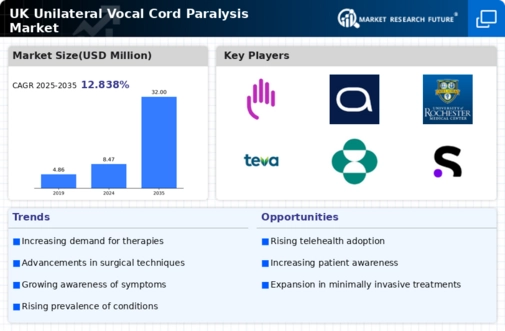Advancements in Surgical Techniques
Innovations in surgical techniques are significantly influencing the unilateral vocal-cord-paralysis market. Minimally invasive procedures, such as endoscopic surgeries, are becoming more prevalent, offering patients quicker recovery times and reduced complications. The introduction of robotic-assisted surgeries has also enhanced precision in vocal cord repair, which may lead to better patient outcomes. As these advanced techniques gain traction, healthcare facilities in the UK are likely to adopt them, thereby increasing the availability of effective treatment options. This shift not only improves patient satisfaction but also encourages more individuals to seek surgical interventions for vocal cord paralysis, potentially expanding the market.
Rising Incidence of Vocal Cord Disorders
The unilateral vocal-cord-paralysis market is experiencing growth due to the increasing incidence of vocal cord disorders in the UK. Factors such as aging populations and lifestyle-related health issues contribute to this rise. According to recent health statistics, approximately 3% of the population may experience some form of vocal cord dysfunction, leading to a heightened demand for effective treatment options. This trend suggests that healthcare providers are likely to invest more in therapies and interventions aimed at addressing these conditions, thereby expanding the market. Furthermore, the growing recognition of the impact of vocal cord disorders on quality of life is prompting more patients to seek medical advice, which could further drive the market for unilateral vocal-cord-paralysis treatments.
Enhanced Patient Education and Support Programs
The unilateral vocal-cord-paralysis market is positively impacted by enhanced patient education and support programs. Increased awareness initiatives are helping patients understand the symptoms and treatment options available for vocal cord paralysis. Healthcare providers are implementing educational campaigns that inform patients about the importance of early diagnosis and intervention. This proactive approach may lead to a higher rate of diagnosis and treatment uptake, thereby expanding the market. Furthermore, support programs that connect patients with healthcare professionals and resources can foster a community of informed individuals, encouraging more people to seek help for their vocal cord issues.
Growing Investment in Healthcare Infrastructure
The unilateral vocal-cord-paralysis market is benefiting from increased investment in healthcare infrastructure across the UK. Government initiatives aimed at enhancing healthcare facilities and services are likely to improve access to specialized treatments for vocal cord disorders. For instance, funding for otolaryngology departments is expected to rise, allowing for better diagnostic tools and treatment options. This investment may lead to a more robust healthcare system capable of addressing the needs of patients with unilateral vocal cord paralysis. As a result, the market could see a surge in demand for therapies and interventions, driven by improved healthcare access and quality.
Emerging Biologics and Pharmacological Treatments
The unilateral vocal-cord-paralysis market is witnessing a shift towards emerging biologics and pharmacological treatments. Recent research indicates that biologic therapies may offer new avenues for managing vocal cord paralysis, potentially improving patient outcomes. As pharmaceutical companies invest in the development of these innovative treatments, the market is likely to expand. The introduction of new drugs that target the underlying causes of vocal cord dysfunction could provide patients with more effective options. This trend suggests a growing interest in research and development within the market, which may lead to a broader range of therapies available for patients suffering from unilateral vocal cord paralysis.





















Leave a Comment